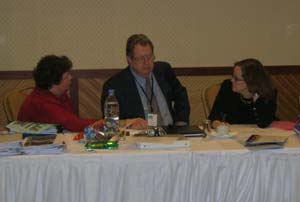 Bill Hogarth, director of NMFS, center, with other members of the US group at the ICCAT meeting in Anatlya, Turkey. The U.S. efforts to bring Europeans close to sustainably fishing tuna in the eastern Atlantic and Mediterranean have been ignored. Rich Ruais photo Bill Hogarth, director of NMFS, center, with other members of the US group at the ICCAT meeting in Anatlya, Turkey. The U.S. efforts to bring Europeans close to sustainably fishing tuna in the eastern Atlantic and Mediterranean have been ignored. Rich Ruais photo
|
This past summer, the world outcry against this continuing slaughter forced the EC to close the Mediterranean fishery for the balance of 2007, but the damage was already done. Evidence from Japanese market sources indicated that with a little more than half the registered farms reporting, 17,830 metric tons were in the cages before the closure, and this does not take into account the usual substantial domestic or international shipments of wild fish to Japan that took place all year.
After successfully blocking the U.S. call for a five-year ban, and a call from Turkey to follow the scientific advice, the EC’s only response to the crisis atmosphere and demands for action was to announce that they would reduce their over-harvest by 1,480 mt each year from 2009-2011. Many of the countries were stunned at the irresponsible position of the EC to allow business as usual during the 2008 upcoming fishing year.
Japan’s response to the crisis was to call for an international meeting in March of 2008 of all Atlantic bluefin stakeholders, from fishermen, farmers and buyers to explain their responsibility to conserve bluefin. The U.S. and Canadian position was that the Japanese proposal was an inadequate response to the problem and that the U.S. would not be a part of the consensus adopting the recommendation. The U.S. and Canada stopped short of blocking the Japanese proposal given the lack of other viable alternatives likely to be adopted.
Few veteran ICCAT observers expect anything to come of the Japanese proposal to basically call for voluntary industry/market action to save the eastern stock. The choice before the Mediterranean fishing industries now is to stop fishing immediately and absorb hundreds of millions of dollars of immediate losses; or fish the next three seasons, risking stock collapse, but, in the meantime, recouping as much of their investment as possible.
“We offered a proposal to suspend fishing to give the nations in the eastern bluefin tuna fishery time to implement the monitoring, control and surveillance measures necessary to comply with the current regulation. The record clearly demonstrates a lack of compliance,” said Dr. Hogarth in a NOAA press release. “We hope the measures adopted at this meeting means that all nations fishing eastern Atlantic and Mediterranean bluefin tuna will follow through on their commitments. However, we could not be part of a consensus that this measure is enough when the looming crisis is so great.”
The U.S. repeatedly noted the strong scientific evidence of stock mixing, and the damage overfishing in the East was having on western fisheries, especially here in the U.S. But the evidence of strong Canadian fisheries the last three years also supports U.S. fishermen views that inadequate forage and other factors are also contributing to the magnitude of the fourth disappointing catch season in a row.
The failure of ICCAT to respond in 2007 to the repeated scientific advice about a pending collapse of the stock makes a listing of Atlantic bluefin tuna at the next meeting in 2010 of the Convention on International Trade in Endangered Species almost a certainty. A CITES Appendix 1 listing will ban all international trade in the species east and west. It is unclear whether the U.S. would continue to allow domestic sales or recreational fishing under a CITES listing.
 The conference room in Antalya, Turkey where the International Committee for the Conservation of Atlantic Tuna was held, November 10-18, 2007. Despite calls to reopen the debate on the fifteen-year recovery plan for eastern bluefin tuna which was adopted last year. Delegates decided to continue to implement the plan as agreed for another year. Rich Ruais photo The conference room in Antalya, Turkey where the International Committee for the Conservation of Atlantic Tuna was held, November 10-18, 2007. Despite calls to reopen the debate on the fifteen-year recovery plan for eastern bluefin tuna which was adopted last year. Delegates decided to continue to implement the plan as agreed for another year. Rich Ruais photo
|
North Atlantic Swordfish
No action on North Atlantic swordfish was expected or taken during the 2007 meeting. There will be another stock assessment on swordfish in 2008 and potential changes to quota shares are expected to be highly controversial. The U.S. has not caught its swordfish quota since 1997 and several countries are lining up to make a play for our unused quota.
A recently announced NOAA proposal to do pelagic longline research in one of the major U.S. EEZ closed areas may provide for some increase in U.S. catches and help argue that the U.S. is serious about swordfish industry revitalization.
Mediterranean Swordfish:
A conservation plan was adopted for Mediterranean swordfish known to be a different species of swordfish with limited mixing and different growth rates than the Atlantic stock. The maximum sustainable yield is believed to be about 14,000 mt, which baffles many scientists noting the much smaller Mediterranean Sea, yet having an equivalent biomass with the entire North Atlantic. The main fishery problem is excessive catches of small fish. The plan’s singular measure is to put in place a 30-day closure from October 15 to November 15.
International Circle Hook Workshop
The U.S. announced an International Workshop next spring to promote further research on the value of using circle hooks to reduce bycatch mortality. The plan is to encourage other countries to do “well conducted research projects with their fishing industry using comparable gear and bait modifications, with the goal of using those results to implement measures (e.g. to modify or substitute circle hooks for closed areas) domestically and through the ICCAT process.” The Workshop “will also review the latest design in proven dehooking and safe handling and release equipment and practices ensuring maximum survival of billfish, sea turtles and other bycatch.”
Bigeye and Yellowfin
Finally, the U.S. pressed hard to get an action on the Gulf of Guinea fisheries for bigeye and yellowfin tuna. The U.S. is especially concerned about the high percentage (i.e.70%) of juveniles being taken in the fisheries, which, in turn, denies fishing opportunities for U.S. commercial and recreational fisheries on smaller numbers of mature bigeye adults. Given the relative good health of the resource, however, ICCAT decided to wait until 2008 to study new management measures for the stocks.
Rich Ruais is the Executive Director of the Blue Water Fishermen’s Association and the East Coast Tuna Association.
|





